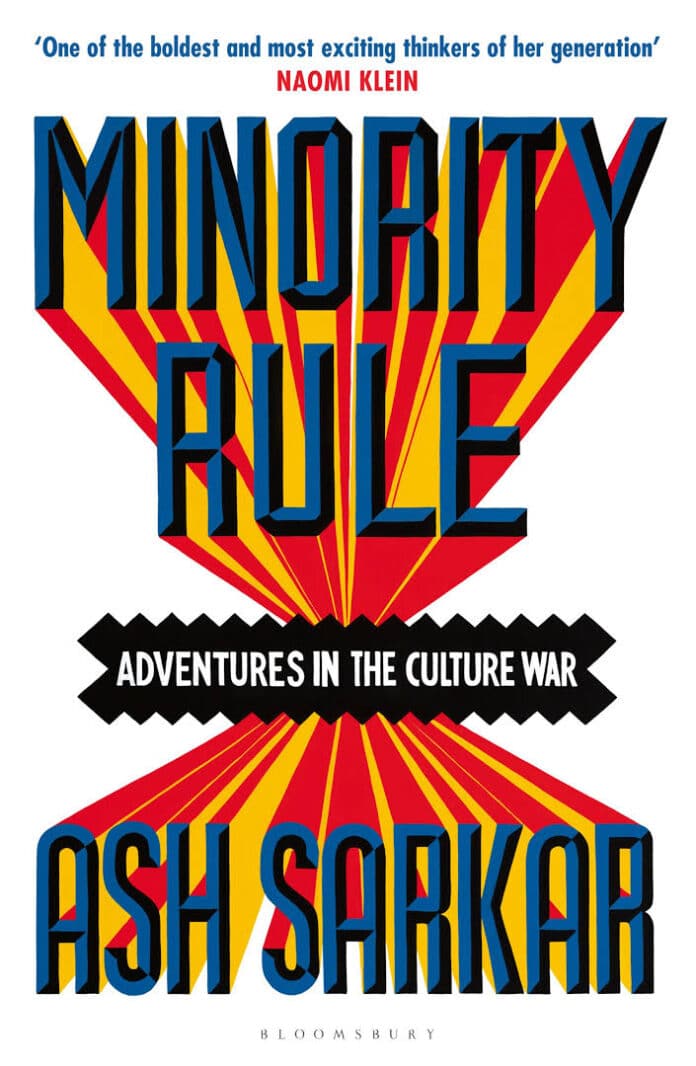The book is a deep dive into the increasingly polarised public debates which centre around questions of identity. The issues it takes on are perhaps even more pressing now than they were at the time the book was drafted.
Claire Laker-Mansfield, Socialist Alternative (ISA in England, Wales and Scotland)
In Minority Rule, Novara Media editor Ash Sarkar addresses the ‘culture wars’ that have become so central to the political landscape of Britain. The book is a deep dive into the increasingly polarised public debates which centre around questions of identity. It addresses how this plays out in the media, who benefits, and how the political left is positioned within this context.
The issues the book takes on are perhaps even more pressing now than they were at the time the book was drafted. It was written before Trump assumed power for the second time — a boost for the right around the world. The far-right riots which broke out in August 2024 are referred to only in an epilogue, which had to be written after the main draft had been completed.
Flaws in identity politics
Perhaps surprisingly to some readers, the book begins not with a critique of the poisonous and divisive politics being promoted by the right, but by looking at the political ideas and approaches which have dominated on the left over the last period. The first chapter is titled “how the ‘I’ took over identity politics”. In it, Sarkar critiques the way that subjectivity has increasingly become the primary lens through which the world is viewed and understood on the left. She correctly points towards defeats for the working class and neoliberalism’s success in weakening the organisations of collective struggle as being the key background to this.
The criticisms she makes of the dominant forms of left identity politics are not necessarily new or groundbreaking. But it is significant that a figure as prominent as Ash Sarkar, who has very much been part of the circles in which these ideas are hegemonic, has chosen to make these arguments so sharply. It is also significant that she points specifically towards Marxism as the most useful framework for understanding how society works.
The opening chapter of Minority Rule charts quite effectively how a form of identity politics characterised by an overwhelming focus on individual ‘lived experience’ has become predominant on the left. In this way of thinking, oppressive ‘systems’ tend to be understood as the accumulation of millions of individual power differentials and oppressive interactions. This contrasts with a Marxist view, which looks at the economic structures that concentrate power and wealth in the hands of a tiny few, and then examines the way that these generate, perpetuate and are maintained by different forms of oppression.
Ash Sarkar describes how an understanding of oppression which tends to reduce itself to focussing on the dynamics of interpersonal interaction — often emphasising individual performative gestures instead of collective mass struggle — has led radical movements which pose a challenge to the establishment to become increasingly disarmed. “Today, identity politics in most of its articulations is confused, atomised and oddly unambitious”, she writes. This is a succinct and accurate statement.
Her approach throughout the book tends towards the anecdotal. This certainly has its place. It makes the book an easy and engaging read, even if it is not always rigorously scientific. Sarkar draws on her own experiences of how the dominant form of left-wing identity politics can derail useful discussion or point away from united struggle. There are stories that sound familiar to anyone who has been active on the left in Britain over the last decade — a debate about fighting climate change is shut down over perceived violence when a speaker swears at the audience, online call-outs escalate rapidly into bitter social media pile-ons, etc.
Sarkar points to the ways an emphasis on cataloguing and delineating the experiences of different groups of oppressed people has created a “logic of irreducible difference”. She critiques the murky concept of ‘allyship’ and its confusing exhortation of individuals to ‘transfer your privilege’ to those who face forms of oppression which you do not. She points to how ideas like these are malleable enough to be embraced (at least in words) by some of the most violently oppressive capitalist institutions on the planet. She strikingly recalls the (pre-Trump era) “humans of the CIA” ad campaign, which seemingly embraced ‘intersectionality’.
Theory
This kind of example is self-evidently absurd. But if there is a weakness in Ash Sarkar’s argument, it is that she stops short of drawing any explicit conclusions about the flaws in theoretical ideas she is describing. Her critiques of the real-world ways in which different ideas (intersectionality, privilege theory etc) are used and abused are salient. But the actual theories these terms denote are essentially held to be sound.
For example, later in the book, she accurately describes the absurdity of the idea that ‘white privilege’ is something a person could consciously ‘give up’. She considers the example of a working-class white person who might be struggling at school, in the care system, or unable to afford food or energy. Clearly, it makes little sense to ask a person in those circumstances to “transfer privilege” to anyone. Yet, at the same time, Sarkar affirms the basic validity of the academic Peggy McIntosh’s privilege theory.
Here, there is a failure to draw the link between the approaches she rightly describes as problematic in practice and what underpins them in terms of theory. Does the “rationale of competing interests” she critiques not have a logical connection to a theory which assigns ‘privilege’ to everyone who doesn’t experience a particular form of oppression? Indeed, ‘privilege’ by this definition applies broadly to a series of negatives — not facing racial discrimination, not being vulnerable to gender violence, not being disabled by capitalist society etc. But surely this contributes to the distinct “lack of ambition” Sarkar describes as characterising so much modern left-wing identity politics. “Education is a right, not a privilege” is the slogan. But if not experiencing racism is thought of as a ‘privilege’ rather than as a right — to which everyone should be entitled and for which we must fight — it inevitably lowers people’s sights. It logically points towards an emphasis on the individual and away from collective struggle and solidarity.
That’s not to deny the obvious point that those who do not experience particular forms of oppression have relative advantages in life as a result. It is not to deny that the oppression which is woven into the structure of capitalist society expresses itself in the interpersonal. Inevitably it does, and of course this should be challenged — both on an individual level and (most effectively) through the means of collective action. But Sarkar is correct when she argues that there is all too often an excessive focus on what she terms “prefigurative politics” — an insistence that political organising groups must first purge themselves of every vestige of oppressive thought or behaviour before they can begin the work of trying to fight for change in the world outside this bubble.
Indeed, the instruction to “do the work” in many activist circles — especially those most unmoored from organising in workplaces — rarely refers to any actual organising. Instead, this is usually a call to engage in self-reflection and self-improvement. These are not bad things in and of themselves. Political education around questions of oppression is a crucial and urgent task of the labour movement. Challenging sexist or racist ideas and behaviours within it is essential for ensuring its unity. Nevertheless, an overly harsh and unforgiving approach — especially towards unintended microaggressions or mistakes clearly borne out of a lack of education — can also contribute to activists becoming paralysed by introspection, or even sliding into inactivity altogether. Equally, improving our own understanding does not by itself challenge the massive material forces which generate and maintain oppression under capitalism.
“Cult of victimhood”
Indeed, the question of how society is structured under capitalism and why that creates inequality and oppression has often been pushed into the background by a relentless focus on the subjective. Refreshingly, Sarkar points explicitly towards Marxism as the most useful set of ideas we have for understanding the world at a deeper level. She contrasts the Communist Manifesto’s “ambitious” call to build a movement of the “immense majority” to what she describes as a kind of “cult of victimhood”, that has developed within many left-wing organising spaces today. She describes this as a culture in which lived experience of violence and oppression becomes a kind of currency — conferring onto individuals political authority.
The book accurately describes how competitive victimhood is not just something which exists on the political left. There is what Sarkar terms an ‘identity politics of majorities’ on the right. She charts effectively how the right has developed a narrative which paints marginalised minority groups as linked to a shadowy ‘elite’, conspiring to oppress the majority. This creates the topsy turvy world in which the main threat to cis women is trans women, in which the real victims of racism are white people, in which the villains in the housing crisis are refugees, not millionaire landlords.
In an interesting chapter, Sarkar recounts the evolution of the political discussion around class this century. In particular, she charts the way in which the portrayal of the working class as feckless ‘chavs’ morphed into the current valorisation of the so-called “white working class”. In this narrative, the ‘white working class’ has interests and views which are presented as being entirely separate from and contradictory to those of all other workers. Embarrassingly and devastatingly, she exposes the way certain capitalist commentators (James Delingpole and Melanie Phillips in particular) shifted almost overnight from describing white working-class people as ‘feral’ to talking about them as ‘deeply, passionately, patriotic and attached to democracy’.
Class struggle
The chapter that describes this process points to the 2011 riots as a landmark political moment. These had been sparked by the police killing of an unarmed black man, Mark Duggan. The rioting began in Tottenham, where the fatal shooting took place. But it rapidly spread across the country, with young people of all racial backgrounds participating. Here she rightly points to some of the similar social conditions faced by working-class youth across different demographics. These certainly were central to creating this generally disorganised (and in many places minimally political) explosion of anger.
But 2011 was also a year in which the working class as an organised force had the opportunity to assert itself — something which is omitted from the text altogether. Just a few months after the riots, there was a de-facto public sector general strike, which showed the strength of the unified working class in all its diversity. The significance of this struggle and of its defeat — which was facilitated by the right-wing trade union leaderships — is an important piece of missing context. Had the working class been able to score a major victory early on in the struggle against austerity in Britain, it could have helped undermine the basis for the growth of divisive ideas which pit working-class people against one another in a competition for scarce resources.
This is ultimately the purpose of stoking ‘culture wars’ from the perspective of the ruling class. Their aim is to polarise society along lines other than those of class — to divide and weaken the workers’ movement and misdirect blame for the catastrophic crises of their system. Usefully, Sarkar refers back to the scientific understanding of class that Marx provides, attempting to explain this in a modern context. She contrasts this with the vague cultural definitions or rigid marketing categorisations commonly used within the capitalist media.
Minority Rule vividly describes how the degeneration of so much ‘journalism’ into churning out clickbait has helped feed culture war narratives. Social media amplifies ‘heat not light’. Sarkar highlights how politicians can get drawn into the business model of capitalist media outlets by being rendered pundits. They all too often behave as if their main role is as commentators rather than political actors — well prepared to answer questions on the latest media ‘micro-events’ but totally incapable of addressing the big questions facing society.
Capitalism’s reactionary turn
Perhaps the biggest weakness of the book is that it sometimes focuses too much on the superficial. The rise of the right internationally is rooted in the successive and deep crises of the capitalist system. It is a symptom of the ruling class’s inability to ‘rule in the old way’.
This relates to the seismic changes that have taken place in the world over the recent period. We have transitioned from one era to another. The age of neoliberal globalisation has reached its limit. The period of history which we have now entered is one in which inter-imperialist conflict is the defining feature. Militarism, nationalism, protectionism and authoritarianism are the political expressions of this shift. The capitalist class is increasingly turning towards reaction in order to protect itself in the face of crisis. Whatever is left of a social base for ‘centrist’ neoliberal politicians is rapidly and dramatically disintegrating. A culture-wars clickbait industrial complex can certainly help to reinforce these processes. But it is more a symptom than it is a cause.
Despite this weakness, Minority Rule ends with a refreshing re-assertion of some Marxist fundamentals. Sarkar correctly states that “the politics we’ve got are a reflection of the balance of class forces within society”. She points to the potential of united struggle: “nothing frightens those hoarding power and wealth more than when people are able to overcome their differences and hone their anger on a single, upward target”.
This is a positive note to end on. But Trump 2.0 and the rise of the right in Britain, particularly Farage’s Reform Party, add urgency to this call. As Ash Sarkar rightly says, this doesn’t mean ditching struggles around questions of identity and oppression. In fact, these need to be massively stepped up. But it does mean organising in a way that fights to build solidarity. It means relying on the economic power we have as workers, and taking united action, especially strike action, to bring about change. In the view of Socialist Alternative, it means urgently fighting for a new left party rooted in the living struggles of working-class and oppressed people. And it means fighting for revolutionary socialist change — something that will only be possible on the basis of an “immense movement” of the multi-racial, multi-gendered working class.




